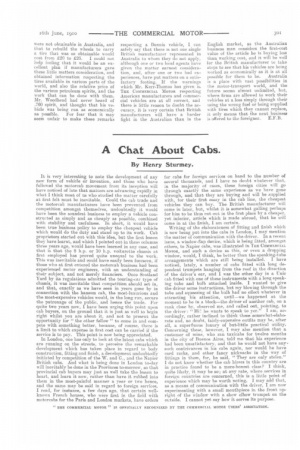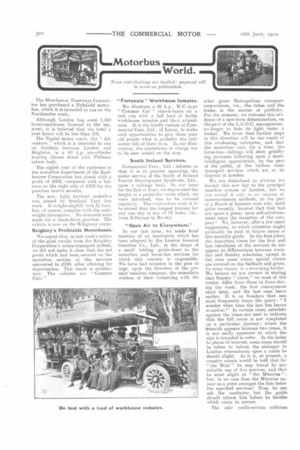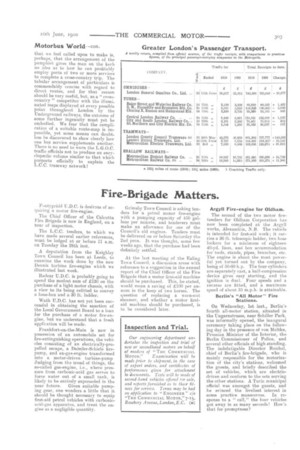A Chat About Cabs.
Page 7

Page 8

Page 9

If you've noticed an error in this article please click here to report it so we can fix it.
By Henry Sturrney.
It is very interesting to note the development of any new form of vehicle or inventiare and those who have followed the motorcab movement from its inception will have noticed of late that matters are advancing rapidly in what I think most of us who studied the matter carefully at first felt must be inevitable_ Could, the cab trade and the motorcab manufacturers have been prevented from competition amongst themselves, undoubtedly it would have been the soundest business to employ a vehicle constructed as simply and as cheaply as possible, combined with stability and usefulness. In short, it would have been true business policy to employ the cheapest vehicle which would do the duty and stand up to its work. Cab proprietors started out with this idea, but the first lesson they have learnt, and which I pointed out in these eolunins three years ago, would have been learned in any case, and that is that the 8 hp. or 10 h.p. voiturette chassis at first employed has proved quite unequal to the work. This was inevitable and could have easily been foreseen, if those who at first entered the motorcab business had been experienced motor engineers; with an understanding of their subject, and not merely financiers. Once Scotland Yard by its regulations admitted the touring-ear type of chassis, it was inevitable that competition should set in, and that, exactly as we have seen in years gone by in connection with the hansom cab, the most-luxurious and the most-expensive vehicles would, in the long run, secure the patronage of the public, and hence the trade. For (pita two years now, I have been urging this point upon cab buyers, on the ground that it is just as well to begin right whilst you are about it, and not to present the opportunity for "the other fellow " to come in and compete with something better, because, of course, there is a limit to which expense in first cost can be carried if the service is to pay. This point is now being appreciated. In London, one has only to look at the latest cabs which are running on the 8-Lreete, to perceive the remarkable development which has taken place in regard to body construction, fitting and finish, a development undoubtedly initiated by competition of the W. and C., and the Napier British cabs. And what is being done in London to-day will inevitably be done in the Provinces to-morrow, so that provincial cab buyers may just as well take the lesson to heart, and learn it now, rather than have it subbed into them in the most-painful manner a year or two hence, and the same may be said in regard to foreign services. I read, for instance, a few days ago, that certain wellknown French houses, who were first in the field with motorcabs for the Paris and London markets, have orders for cabs for foreign services on band to the number of several thousands, and I have no doubt whatever that, in the majority of cases, these foreign cities will go through exactly the same experience as we have gone through, and. that they are buying and will be supplied with, for their first essay in the cab line, the cheapest vehicles they can buy. The British manufacturer will come in later, but, whilst it is somewhat galling perhaps for him to be thus cut out in the first place by a cheaper, yet inferior, article which is made abroad, that he will come in at the finish, I am certain. Writing of the elaborateness af fitting and finish which is now being put into the cabs in London, I may mention the matter of communication with the driver. In a recent issue, a window-flap device, which is being fitted, amongst others, to Napier cabs, was illustrated in TILE COMMV;RCIAL MOTOR, and such a device as this, or even a dropping window, would, I think, be better than the speaking-tube arrangements which are still being installed. I have noticed, lately, a number of cabs fitted with long dependent trumpets hanging from the roof in the direction of the driver's ear, and. I was the other day in a Unic cab fitted with one of these instruments with a long speaking tube and bulb attached inside. I wanted to give the driver some instructions, but my blowing through the tube and squeezing of the bulb had no effect whatever in attracting his attention, until—we happened at the moment to be in a block—the driver of another cab, on a rank close by, observed me, and called aut, pointing, to the drieer: " Hi! he wants to speak to yer." I am, accordingly, rather inclined to think these somewhat-elaborate and, no doubt, fairly-expensive outfits may be, after all, a superfluous luxury of but-little practical utility. Concerning these, however, I may also mention that a customer of mine, who ran taxicabs for twelve months in the city of Buenos Aires, told me that his experience had been unsatisfactory, and that he would not have any. such contrivances in his cabs again, nor would. he have card racks, and other fancy nicknacks in the way of fittings in them, for, he said, "They are only stolen." I do not know whether the cab hirers in this country are in practice found to be a more-honest class? I think, quite likely; it may be so; at any rate, where services in foreign countries are concerned, this is a. little point of experience which may be worth noting. I may add that, as a means of communication with the driver, I am now experimenting with a. small mouthpiece in the front upright of the window with a show elbow trumpet on the outside. I cannot yet say how it serves its purpose.
The Manchester Tramways Committee has purchased a Ryknield motorbus, which it is intended to run on the Northenden route.
Although London has some 1,500 horse-omnibuses licensed at the moment, it is believed that the total a year hence will be less than 500.
The Napier motor coach, the " Adventure," which it is intended to run on Sundays between London and Brighton, is a 60 h.p. six-cylinder touring chassis fitted with Pullman saloon body.
The eighth year of the existence of the motorbus department of the Eastbourne Corporation has closed with a profit of £662, compared with a balance on the right side of £250 for the previous twelve months.
The new, light Leyland motorbus was passed by Scotland Yard last week. It weighs slightly over 31 tons. but, of course, complies with the axleweight alternative. No demands were made for a chain-drive gearbox. The vehicle is now on the Kingsway route.
Heighley's Profitable Motorbuses.
We regret that, in last week's notice of the good results from the Keighley Corporation's urban-transport system, we did not make it clear that the net profit which had been secured on the motorbus section of the services amounted to 1;100, after allowing for depreciation. This result is satisfactory. The vehicles are " Commer Cars." "Fortunate" Workhouse Inmates.
We illustrate a 32 h.p., W.C.-type " Commer Car " char-a-bancs on a test run with a full load of feeble workhouse inmates and their attendants. It is the kindly custom of Commercial Cars, Ltd., of Luton, to make such opportunities to give these poor old people what is probably the only motor ride of their lives. In our illustration, the attendants in charge are to be seen seated on the step.
South Ireland Services.
Commercial Cars., Ltd., informs us that it is at present operating the motor service of the South of Ireland Tourist Development Syndicate, Ltd., upon a mileage basis. In our issue for the 2nd of June, we deprecated the length of a particular route which, we were informed, was to be covered regularly. The contractors wish it to be stated that the longest journey for any one day is one of 76 miles, viz.. from Killarney to Bantry.
"Open Air to Eiterywhere."
In our last issue, we made brief mention of an innovation which has been adopted by the London General Omnibus Co., Ltd., in the shape of a small folding guide-sheet to the motorbus and horse-bus services for which this concern is responsible. We have had occasion in the past to urge, upon the directors of the premier omnibus company, the immediate wisdom of their competing with the
other great Metropolitan transport corporations, viz., the tubes and the trams, in the matter of publicity. For the moment, we welcome this evidence of a new-born determination, on the part of the L.G.O.C. management, no longer to hide its light under a bushel. We trust that further steps in this direction will be the result of this awakening enterprise, and that the motorbus—and, for a time, the horse-bus—takings will show gratifying increases following upon a moreintelligent appreciation, on the part of the public, of the railless roadtransport services which are at its disposal in London.
We are disinclined to criticise too harshly this new key to the principal omnibus system of London, but we can accept it only as an earnest of more-strenuous methods, on the part of a Board of business men who, until quite recently, boasted that they had not. spent a penny upon self-advertisement since the inception of the company! We, however, offer a few small suggestions, to which attention might profitably be paid in future issues of this monthly guide. In the first place, the departure times for the first and last omnibuses of the services do not appear to differentiate between weekday and Sunday schedules, except in the nine cases where special routes are covered on the Sabbath and given, for some reason, in a mourning border. We believe we are correct in stating that Sunday " times," on most of the routes, differ from those in force during the week ; the first conveyances start later, and the last ones leave earlier. It is on Sundays that one most frequently hears the query : " I wonder what time the last bus leaves so-and-so ?" In certain cases, asterisks against the times are used to indicate that the full route is not completed on a particular journey ; where the 'asterisk appears between two times, it is not easily apparent to which the sign is intended to refer. In the index to places of interest, some steps should he taken to inform the stranger to London whereabouts upon a route he should alight. As it is, at present, a country cousin would be told that for "the Mint" he may travel by any suitable one of five services, and that he must alight at "the Minories " but, in no case does the Minories appear as a point amongst the lists below the specified services! True, he can ask the conductor, but the guide should inform him before he decides which route to pursue.
The only really-serious criticism that, we feel called upon to make is, perhaps, that the arrangement of the pamphlet gives the man on the kerb no idea as to how he can profitably employ parts of two or more services to complete a cross-country trip. The tabular arrangement of particulars is commendably concise with regard to direct routes, and for that reason should be very useful, but, as a " crosscountry " competitor with the illuminated maps displayed at every possible
point, throughout London by the Underground railways, the outcome of some further ingenuity must yet be embodied. We fear that the complication of a suitable route-map is impossible, yet some means can doubtless he discovered to show clearly how one bus service supplements another. There is no need to warn the L.G.O.C. traffic officials not to produce an encyclopredie volume similar to that which
purports officially to explain the L.C.C. tramway network!




















